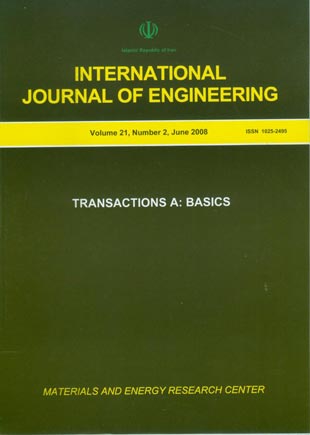فهرست مطالب

International Journal of Engineering
Volume:21 Issue: 2, Jun 2008
- Transactions : A : Basic
- تاریخ انتشار: 1386/07/17
- تعداد عناوین: 8
-
-
Page 105An optimal strategy based on minimum effort control and also with terminal positionconstraint is developed for an exoatmospheric interceptor with a fixed- interval guidance time. It isthen integrated with sliding-mode control theory to drive an optimal sliding-mode guidance law forfixed-interval guidance time. In addition, this guidance law is generalized for intercepting anarbitrarily time-varying target maneuver. Robustness of the new guidance method againstdisturbances and good miss distance performance are achieved by the second method of Lyapunovand simulation results. The presented guidance law is simple to implement in practical applications.
-
Page 113Abstract In this investigation, nucleate boiling heat transfer coefficients were experimentally measured during pool boiling of mixtures, consisting of water/monoethanolamine and water/diethanolamine on a horizontal heating rod, under atmospheric pressure. The experiment was carried out below 205 kW.m-2 heat flux, over a wide range of concentrations. These experiments include, measurement of pool boiling heat transfer coefficient and also visual information. Applicability of the existing main correlations is briefly discussed, with the present experimental data. The major predictions(over and/or under) were observed in some parameter range by the existing correlations. In this investigation the correlations of Fujita et al and Inoue et al, which are structurally the same but have different tuning parameters were modified for this system and the average error has been significantly reduced.
-
Page 133Methods of preparing test specimens in laboratories are particularly important. It also holds true in terms of compaction procedure in predicting pavement performance. The currently available laboratory compactor cannot adequately replicate field compaction conditions, especially the Stone Mastic Asphalt (SMA) mixture. The essential element of SMA mixture comprises of stones that are placed next to or on top of each other, and therefore are greatly affected by the compaction procedure. Conclusion of different studies have indicated that rolling wheel compactor, simulates properties that are closer to field compaction. Turamesin was developed as an improved method oflaboratory slab roller compactor, to provide a solution for the problem of producing laboratoryspecimens, which would represent materials laid and compacted in the field. This paper gives anoverview of Turamesin and discusses the findings of the units'' first phase Pilot Study, conducted inorder to provide specific information, to improve procedures for slab preparation and compaction,also determining the criteria for slab compaction and performance of Turamesin. Turamesin is able tocompact, a slab area measuring; 600 mm by 500 mm, according to clients'' specified thicknesses, withnumber of passes up to 75, within 15 minutes time period. One compacted slab could produce up to16 cylindrical core specimens of 100 mm diameter. Turamesin has shown great potential to beadopted as standard laboratory slab compactor, for asphalt mixtures and seemes to be capable ofsimulating field compaction in terms of operational procedures. However, improvement of theTuramesin will need significant amount of research to develop and finalize the optimum procedures.
-
Page 159This paper proposes a comprehensive, multi-objective, mixed-integer, nonlinear programming (MINLP) model for a cell formation problem (CFP) under fuzzy and dynamic conditions aiming at: (1) minimizing the total cost which consists of the costs of intercellular movements and subcontracting parts as well as the cost of purchasing, operation, maintenance and reconfiguration of machines, (2) maximizing the preference level of the decision making (DM) and (3) balancing intracellular workload. Dynamic CFP divides the planning horizon to smaller periods and considers different product combinations and demands in each period, which may result in cell reconfiguration necessity. Moreover, it is more realistic to take into account the inexact and uncertain (fuzzy) nature of parameters, such as product demand or machine capacity. The main goals of the proposed model is to select a process plan with the minimum cost and also to identify the most appropriate production volume with respect to fuzzy demands and capacities in order to minimize the deviation from the desired production and balanced machine workload.
-
Page 195In this paper a new macroscopic k-ε model is developed and validated for turbulent flow through porous media for a wide range of porosities. The morphology of porous media is simulated by a periodic array of square cylinders. In the first step, calculations based on microscopic v2 − f model are conducted using a Galerkin/Least-Squares finite element formulation, employing equalorder bilinear velocity-pressure elements. Calculations are validated by comparing the results to available data in the literature. In the second step, the volume averaged properties are extracted fromthe microscopic solution of v2 − f model. Then, employing the volume average technique, the macroscopic transport equations of continuity, momentum and k-ε model are derived and modeled. Inthe third step and during the volume averaging process, additional terms appeared in the k-ε model are interpreted and compared with the volume averaged properties that are extracted from the solutionof microscopic v2 − f model. Finally a “v2 − f based” macroscopic k-ε model is developed and validated successfully for a wide range of porosities by comparing the macroscopic data to those predicted by microscopic v2 − f model. Moreover, the results of the calculations are compared with the result of an experimental work in the literature in order to validate the accuracy of the model.

